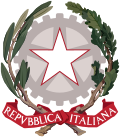| Order of Vittorio Veneto Ordine di Vittorio Veneto | |
|---|---|
 Obverse and reverse | |
| Awarded by the Italian Republic | |
| Type | Order of chivalry |
| Established | 18 March 1968 |
| Country | Italy |
| Eligibility | Military veterans |
| Criteria | Service for 1915–1918 and earlier conflicts |
| Status | Abolished |
| Founder | Giuseppe Saragat |
| Grand Master | President of the Republic |
| Council Chair | Army Corps General |
| Grades | Knight |
| Post-nominals | OVV[ citation needed ] |
| Website | www |
| Statistics | |
| Last induction | 15 March 2010 |
| Precedence | |
| Next (higher) | Order of the Star of Italy |
| Next (lower) | War Cross of Military Valor |
| Ribbon of the order | |
The military Order of Vittorio Veneto (Italian : Ordine di Vittorio Veneto) was an Italian order of chivalry that was founded as national order by the fifth President of the Italian Republic, Giuseppe Saragat, in 1968, "to express the gratitude of the nation" to those decorated with the Medal and the War Cross of Military Valor (Medaglia e Croce di Guerra al Valor Militare) who had fought for at least six months in World War I and earlier conflicts. [1]
Contents
The Order is awarded in the single degree of Knight.
Being awarded more than 50 years after the War, most of the recipients were retired from employment. For the Knights who did not enjoy an income above their tax allowance, a small annuity was granted in favor of those recipients, payable to the widow or minor children on death. The allowance was also granted to those that fought in the former Austro-Hungarian armed forces who became Italian citizens after annexation. [2]
| Ribbon | Class | Full title |
|---|---|---|
| | Knight | Cavaliere dell'Ordine di Vittorio Veneto |
The order was bestowed by decree of the President of the Italian Republic, its head, on the recommendation of the Minister of Defence. A Lieutenant General chaired the council, which investigated applications made by eligible parties to the municipality of residence. With the death of the last surviving Knights of Vittorio Veneto in 2008, [3] [4] the order fell into abeyance and, in 2008, it was formally wound-up by repeal of the original legislation. [5] It was revived anyway on 15 March 2010 in spite of being still abeyant.

| Notable recipients | Death date and age |
|---|---|
| Cav. Girolamo Angelini | 22 May 1991 (aged 91) |
| Cav. Giuseppe Arena | 19 March 1978 (aged 85) |
| Cav. Delfino Borroni | 26 October 2008 (aged 110) |
| Cav. Francesco Domenico Chiarello | 27 June 2008 (aged 109) |
| Cav. Pietro Micheletti | 25 March 2005 (aged 105) |
| Cav. Carmine Pavia | 26 October 1974 (aged 87) |
| Cav. Domenico Piroli | 25 January 1972 (aged 72) |
| Cav. Lazare Ponticelli, Chevalier de la Légion d'honneur | 12 March 2008 (aged 110) |
| Cav. Filippo Rizzo | 1 February 1984 (aged 89) |
| Cav. Marcantonio Rositano | 18 February 1977 (aged 88) |
| Cav. Ugo Matteucci | 1982 (aged 85) |
